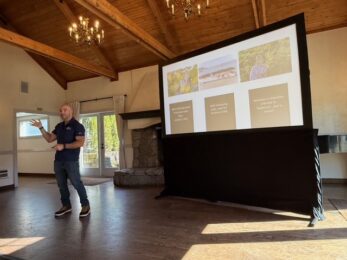‘Regenerate’ joins recycle, reuse and reduce to combat climate change
There’s something new down on the farm. Have you heard? Carbon farming, it’s called. And it’s hoped it will do something more than feed us. It could help save us.
Since we’ve advanced beyond being hunter-gatherers, we’ve depended on farms for our survival. Yet agriculture and ranching is the second-largest contributor to carbon dioxide emissions, after power generation. The use of fossil fuel-based fertilizers, pesticides and herbicides, tilling the soil, over-grazing, tractors and other farm machines all release CO2.
Carbon farming, on the other hand, returns nutrients to the soil to “trap” CO2 and build stronger food systems.
The three Rs—reduce, recycle and reuse—have been part of the hospitality and meeting planners’ lexicon for almost a decade. As extreme climate and climate change have advanced beyond distant threats to an ever-more scary reality, sustainability has become more than a cuddly concept to embrace.
This exciting new approach to sustainability is also called regenerative farming. It’s the fourth R.
Agriculture is the one economic sector that can transform itself from a net emitter of CO2 to a net sequesterer of carbon, which can be safely stored in soils for decades or even centuries, according to Carbon Cycle Institute (CCI), an outgrowth of the ground-breaking (forgive the pun) Marin Carbon Project (MCP), founded in 2008 in Northern California. “There is no other human-managed realm with this potential,” notes CCI, where the mission is “to stop and reverse climate global change by advancing science-based solutions that reduce atmospheric carbon while promoting environmental stewardship, social equity and economic sustainability.”
The role of grazing livestock in climate change is fiercely debated. Cows burp and excrete methane, which is 20 times worse than CO2. Yet MCP has demonstrated that domesticated livestock play an important symbiotic role in keeping pastures healthy and carbon locked underground. The most advanced ranchers, such as Albert Straus of Straus Family Creamery, a participant in MCP, use biodigesters to capture methane from cow waste and convert it to electricity.
Healthy Soil is Our Friend
At the heart of regenerative agriculture is healthy soil. After chemical fertilizers came into ubiquitous use beginning in the 1950s, farmers began relying on these artificial additives, rather than nature, to feed their crops. As a result, top soil—the upper layer of dirt that contains all the living organisms and nutrients—has been degraded around the world.
“In 2014, soil scientists estimated that a third of the world’s topsoil had already been lost, and that it could be completely gone by 2075,” Brittany Szczepanik, senior project manager of sustainability at NSF International, told mindbodygreen.com.
The New York Times Magazine recently published an article by Moises Velasquez-Manoff, “Can Dirt Save the Earth?” One featured farmer was Darin Williams, who lives near Waverly, Kansas. “See how that crumbles into a cottage-cheese look?” Williams asked as he cradled a fistful of earth. “That’s what you want.” Velasquez-Manoff wrote: “Small clods fell through his fingers. Worm holes riddled the dirt, giving it a sponge-like quality that was critical, he said.
By focusing on soil health, Williams says he has reduced his use of herbicides by 75 percent and fertilizers by 45 percent. He doesn’t use pesticides—he relies instead on beneficial insects for pest control—and he saves money by not buying expensive, genetically modified, herbicide-resistant seed. He estimates that he produces a bushel of soybeans for about 20 percent less than his conventionally farming neighbors. Last fall, he claims, his yields ranked among the highest in the county. While doing all this, he has so far raised the amount of soil organic matter, a rough predictor of soil carbon concentrations, from around 2 percent to 3.5 percent in some fields. Another farmer profiled said he has more than tripled his soil carbon since the 1990s.
Further studies are needed to win over skeptics about the scalability and worldwide potential of carbon farming. There can be no doubt, however, that keeping carbon in the ground instead of in the atmosphere is an idea worth the effort.
What Planners Can Do
1. Compost. Composting is a key strategy in regenerative agriculture. Yet confusion over how and why to compost remains widespread. So, why not design a team-building activity around this earth-friendly practice? Start by inviting a local expert to give a composting primer to your group. Teams can then compete to create a social media campaign, a video or posters for local schools to promote the benefits of composting. And, of course, be sure to have composting bins (with clear labeling and, preferably, a trained monitor) at mealtimes!
2. Adopt an organic farm. Soil health is central to small-scale organic farming. As a CSR activity, organize a pop-up organic market, followed by a field trip to the organic farm, where the techniques and importance of regenerative farming and healthy soil can be demonstrated and discussed.




